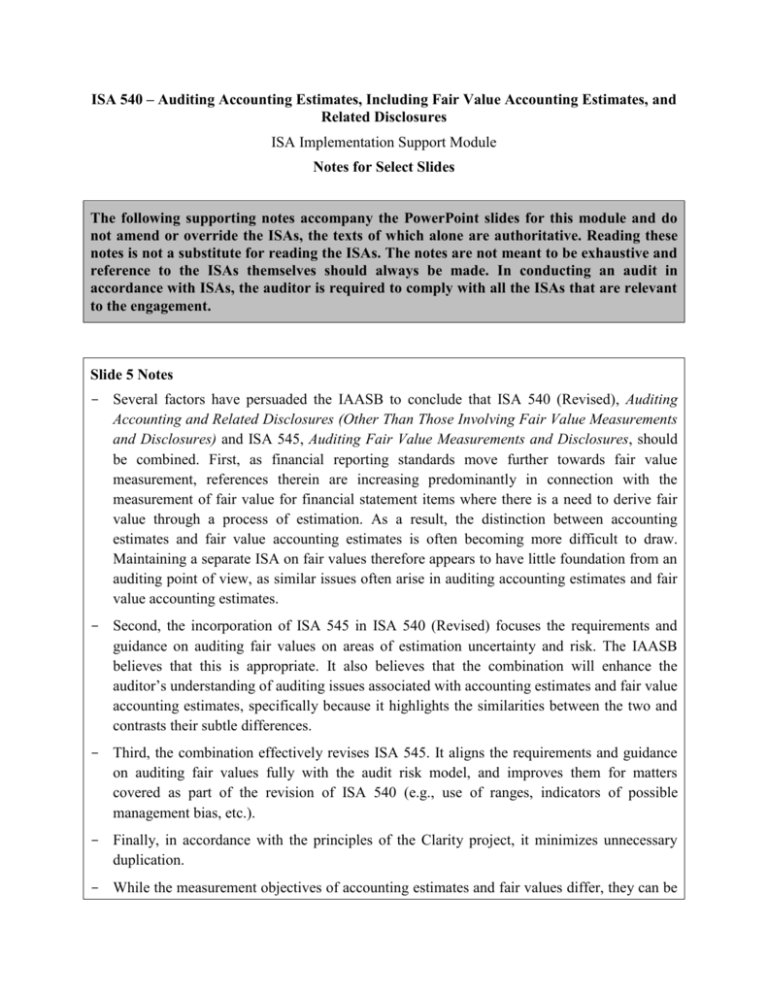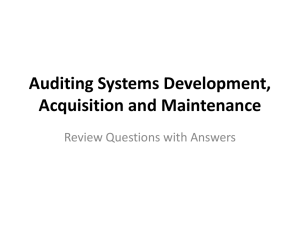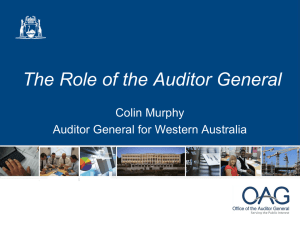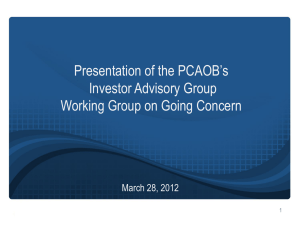
ISA 540 – Auditing Accounting Estimates, Including Fair Value Accounting Estimates, and
Related Disclosures
ISA Implementation Support Module
Notes for Select Slides
The following supporting notes accompany the PowerPoint slides for this module and do
not amend or override the ISAs, the texts of which alone are authoritative. Reading these
notes is not a substitute for reading the ISAs. The notes are not meant to be exhaustive and
reference to the ISAs themselves should always be made. In conducting an audit in
accordance with ISAs, the auditor is required to comply with all the ISAs that are relevant
to the engagement.
Slide 5 Notes
- Several factors have persuaded the IAASB to conclude that ISA 540 (Revised), Auditing
Accounting and Related Disclosures (Other Than Those Involving Fair Value Measurements
and Disclosures) and ISA 545, Auditing Fair Value Measurements and Disclosures, should
be combined. First, as financial reporting standards move further towards fair value
measurement, references therein are increasing predominantly in connection with the
measurement of fair value for financial statement items where there is a need to derive fair
value through a process of estimation. As a result, the distinction between accounting
estimates and fair value accounting estimates is often becoming more difficult to draw.
Maintaining a separate ISA on fair values therefore appears to have little foundation from an
auditing point of view, as similar issues often arise in auditing accounting estimates and fair
value accounting estimates.
- Second, the incorporation of ISA 545 in ISA 540 (Revised) focuses the requirements and
guidance on auditing fair values on areas of estimation uncertainty and risk. The IAASB
believes that this is appropriate. It also believes that the combination will enhance the
auditor’s understanding of auditing issues associated with accounting estimates and fair value
accounting estimates, specifically because it highlights the similarities between the two and
contrasts their subtle differences.
- Third, the combination effectively revises ISA 545. It aligns the requirements and guidance
on auditing fair values fully with the audit risk model, and improves them for matters
covered as part of the revision of ISA 540 (e.g., use of ranges, indicators of possible
management bias, etc.).
- Finally, in accordance with the principles of the Clarity project, it minimizes unnecessary
duplication.
- While the measurement objectives of accounting estimates and fair values differ, they can be
Module – ISA 540 – Notes for Select Slides
difficult to distinguish in practice and the same audit approach largely applies.
- All the requirements in the ISA are equally applicable to accounting estimates and fair values
and auditors are required to comply with them when auditing both. It is the application and
other explanatory material that guides the auditor in how to comply with the requirements in
both circumstances.
Slide 12 Notes
- ISA 540 focuses the auditor’s work effort on those accounting estimates that have high
estimation uncertainty – especially those that the auditor determines are significant risks.
- Not all estimates have high estimation uncertainty – for example, allowances for doubtful
accounts in a stable business with a large number of relatively small customers can be
predicted with reasonable accuracy based on prior year experience. On the other hand, there
may be high estimation uncertainty when an accounting estimate is relatively complex – for
example, the determination of fair value for some complex financial instruments.
Slide 14 Notes
- The ISA specifies a choice of audit procedures to respond to risks of material misstatement
based on the nature of the accounting estimate.
- The auditor’s decision as to which of these responses, individually or in combination, to
undertake to respond to the risks of material misstatement may be influenced by such matters
as:
o The nature of the accounting estimate, including whether it arises from routine or non
routine transactions.
o Whether the procedure(s) is expected to effectively provide the auditor with sufficient
appropriate audit evidence.
o The assessed risk of material misstatement, including whether the assessed risk is a
significant risk.
- For example, when evaluating the reasonableness of the allowance for doubtful accounts, an
effective procedure for the auditor may be to review subsequent cash collections in
combination with other procedures. Where the estimation uncertainty associated with an
accounting estimate is high, for example, an accounting estimate based on a proprietary
model for which there are unobservable inputs, it may be that a combination of the responses
to assessed risks outlined in the ISA is necessary in order to obtain sufficient appropriate
audit evidence.
- The ISA provides further guidance as to when each of these responses may be most
2/6
Module – ISA 540 – Notes for Select Slides
appropriate, including which may be most appropriate in the context of auditing fair values.
(para references?)
Slide 15 Notes
Developing a Point Estimate or Range
- Developing a point estimate or a range to evaluate management’s point estimate may be an
appropriate response where, for example:
o An accounting estimate is not derived from the routine processing of data by the
accounting system.
o The auditor’s review of similar accounting estimates made in the prior period financial
statements suggests that management’s current period process is unlikely to be effective.
o The entity’s controls within and over management’s processes for determining
accounting estimates are not well designed or properly implemented.
o Events or transactions between the period end and the date of the auditor’s report
contradict management’s point estimate.
o There are alternative sources of relevant data available to the auditor which can be used
in making a point estimate or a range.
- Even where the entity’s controls are well designed and properly implemented, developing a
point estimate or a range may be an effective or efficient response to the assessed risks. In
other situations, the auditor may consider this approach as part of determining whether
further procedures are necessary and, if so, their nature and extent.
- The approach taken by the auditor in developing either a point estimate or a range may vary
based on what is considered most effective in the circumstances. For example, the auditor
may initially develop a preliminary point estimate, and then assess its sensitivity to changes
in assumptions to ascertain a range with which to evaluate management’s point estimate.
Alternatively, the auditor may begin by developing a range for purposes of determining,
where possible, a point estimate.
- The ability of the auditor to make a point estimate, as opposed to a range, depends on several
factors, including the model used, the nature and extent of data available and the estimation
uncertainty involved with the accounting estimate. Further, the decision to develop a point
estimate or range may be influenced by the applicable financial reporting framework, which
may prescribe the point estimate that is to be used after consideration of the alternative
outcomes and assumptions, or prescribe a specific measurement method (for example, the
use of a discounted probability-weighted expected value).
Narrowing a Range
3/6
Module – ISA 540 – Notes for Select Slides
- When the auditor concludes that it is appropriate to use a range to evaluate the
reasonableness of management’s point estimate (the auditor’s range), the ISA requires that
range to encompass all “reasonable outcomes” rather than all possible outcomes. The range
cannot be one that comprises all possible outcomes if it is to be useful, as such a range would
be too wide to be effective for purposes of the audit. The auditor’s range is useful and
effective when it is sufficiently narrow to enable the auditor to conclude whether the
accounting estimate is misstated.
- Ordinarily, a range that has been narrowed to be equal to or less than performance materiality
is adequate for the purposes of evaluating the reasonableness of management’s point
estimate. However, particularly in certain industries, it may not be possible to narrow the
range to below such an amount. This does not necessarily preclude recognition of the
accounting estimate. It may indicate, however, that the estimation uncertainty associated with
the accounting estimate is such that it gives rise to a significant risk. Additional responses to
significant risks are described in paragraphs A102-A115 of the ISA.
- Narrowing the range to a position where all outcomes within the range are considered
reasonable may be achieved by:
(a) Eliminating from the range those outcomes at the extremities of the range judged by the
auditor to be unlikely to occur; and
(b) Continuing to narrow the range, based on audit evidence available, until the auditor
concludes that all outcomes within the range are considered reasonable. In some rare
cases, the auditor may be able to narrow the range until the audit evidence indicates a
point estimate.
Slide 18 Notes
- Financial reporting frameworks often call for neutrality, that is, freedom from bias.
Accounting estimates are imprecise, however, and can be influenced by management
judgment. Such judgment may involve unintentional or intentional management bias (for
example, as a result of motivation to achieve a desired result). The susceptibility of an
accounting estimate to management bias increases with the subjectivity involved in making
it. Unintentional management bias and the potential for intentional management bias are
inherent in subjective decisions that are often required in making an accounting estimate. For
continuing audits, indicators of possible management bias identified during the audit of the
preceding periods influence the planning and risk identification and assessment activities of
the auditor in the current period.
- Management bias can be difficult to detect at an account level. It may only be identified
when considered in the aggregate of groups of accounting estimates or all accounting
estimates, or when observed over a number of accounting periods. Although some form of
4/6
Module – ISA 540 – Notes for Select Slides
management bias is inherent in subjective decisions, in making such judgments there may be
no intention by management to mislead the users of financial statements. Where, however,
there is intention to mislead, management bias is fraudulent in nature.
- During the audit, the auditor may become aware of judgments and decisions made by
management which give rise to indicators of possible management bias. Such indicators may
affect the auditor’s conclusion as to whether the auditor’s risk assessment and related
responses remain appropriate, and the auditor may need to consider the implications for the
rest of the audit. Further, these indicators may affect the auditor’s evaluation of whether the
financial statements as a whole are free from material misstatement, as discussed in ISA 700.
Slide 20 Notes
- The presentation of financial statements in accordance with the applicable financial reporting
framework includes adequate disclosure of material matters. The applicable financial
reporting framework may permit, or prescribe, disclosures related to accounting estimates,
and some entities may disclose voluntarily additional information in the notes to the financial
statements. Such disclosures are relevant to users in understanding the accounting estimates
recognized or disclosed in the financial statements, and sufficient appropriate audit evidence
needs to be obtained about whether the disclosures are in accordance with the requirements
of the applicable financial reporting framework.
- In some cases, the applicable financial reporting framework may require specific disclosures
regarding uncertainties.
- In relation to accounting estimates having significant risk, even where the disclosures are in
accordance with the applicable financial reporting framework, the auditor may conclude that
the disclosure of estimation uncertainty is inadequate in light of the circumstances and facts
involved. The auditor’s evaluation of the adequacy of disclosure of estimation uncertainty
increases in importance the greater the range of possible outcomes of the accounting estimate
is in relation to materiality (see related discussion in paragraph A94 of the ISA).
- In some cases, the auditor may consider it appropriate to encourage management to describe,
in the notes to the financial statements, the circumstances relating to the estimation
uncertainty. ISA 705 provides guidance on the implications for the auditor’s opinion when
the auditor believes that management’s disclosure of estimation uncertainty in the financial
statements is inadequate or misleading.
Slide 21 Notes
- Extant ISA 545, which dealt strictly with fair values, required auditors to determine the need
to use the work of an expert. Extant ISA 540, which dealt with accounting estimates, did not
have a similar requirement. The IAASB was of the view that while this requirement was
5/6
Module – ISA 540 – Notes for Select Slides
particularly relevant in the case of fair value accounting estimates, it would also be
applicable to other types of accounting estimates.
- In planning the audit, the auditor is required to ascertain the nature, timing and extent of
resources necessary to perform the audit. This includes making sure that the engagement
team has the appropriate competence and capabilities, and may result in the identification of
individuals with specialized skills and knowledge to be included on the engagement team. In
many cases, it is likely that such skills and knowledge won’t be necessary – whether because
the estimates are less complex or the engagement team is more experienced in a particular
industry or with that entity. However, as the accounting estimates become more complex, it
may be necessary to bring in someone with expertise not held by the core engagement team.
- For example, when an entity uses a model, or has relied on the work of a management’s
expert, it may be more likely that an auditor’s expert will be needed. This could include, for
example, quantitative experts who review the model used by management, including the
assumptions it uses. These experts may also choose to develop their own models to compare
with the results of that used by management.
Copyright © October 2009 by the International Federation of Accountants (IFAC). All rights reserved. Permission is granted to make copies of
this work provided that such copies are for use in academic classrooms or for personal use and are not sold or disseminated and provided that
each copy bears the following credit line: “Copyright © October 2009 by the International Federation of Accountants (IFAC). All rights
reserved. Used with permission of IFAC. Contact permissions@ifac.org for permission to reproduce, store, or transmit this work.” Otherwise,
written permission from IFAC is required to reproduce, store, or transmit, or to make other similar uses of, this work, except as permitted by law.
Contact permissions@ifac.org.
ISBN: ISBN: 978-1-60815-040-3
6/6








